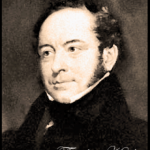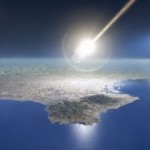Weekly Wrap Volume 51
 The Greatest Practical Joke of the 19th Century, the Berners Street Hoax
The Greatest Practical Joke of the 19th Century, the Berners Street Hoax
The year was 1809. Famed English author, Theodore Hook, made a bet with one of his close friends, the noted architect and writer, Samuel Beazley, that within one week, he could make any house in London the most talked about place in the city. The house he ended up choosing was the home of the widow Mrs. Tottenham on 54 Berners Street, London, which was the same street that Earl Stanhope and the Bishop of Carlisle and of Chester, among other wealthy and well-to-do individuals, lived on at that time. It isn’t known why Hook chose Mrs. Tottenham’s home as no connection between the two is known and Hook himself never explained his selection. It’s entirely possible that it just happened… (more)
 Where Did All the Neanderthals Go?
Where Did All the Neanderthals Go?
For over 150,000 years, our ancient cousins, the Neanderthals (Homo neanderthalensis), thrived throughout Europe until, in the blink of an eye (geologically speaking), they disappeared off the face of the Earth. Several theories have been proposed to explain their extinction, although a consensus is growing that the primary factor was competition with us (Homo sapiens). Despite their annihilation, however, their legacy lives on today – in the human genome. Neanderthal Basics: Living in Europe and Asia from about 200,000 to 40,000 years ago, the Neanderthal shared many characteristics with modern humans, and in fact… (more)
 The Corrupt and Ruthless Californian Who Gave us the Name for “Monterey Jack” Cheese
The Corrupt and Ruthless Californian Who Gave us the Name for “Monterey Jack” Cheese
Cheese predates written history. Ancient Egyptians loved cheese so much that depictions of the cheese-making process were painted in tombs. Homer’s Odyssey talks about how Cyclops stored his cheese. The Greeks and Romans used cheese as a delicious currency. During the Middle Ages, if there was cheese on the dinner table, it meant the family was of at least moderately wealth. (For more on all this, see: A Brief History of Cheese) While cheese has been around for ages, many cheeses we eat today were invented over the last five hundred years. A few were even invented in the United States, Monterey Jack cheese being one of them. So, how did Monterey Jack get its unique name? Before we get into that, we must go back about three hundred years to the Spanish monasteries of California. In the 18th century, Spanish missionaries began their takeover of California. It was on July 16, 1769 when the first Catholic mission was founded… (more)
There are several things that contribute to hangovers, but one of the principal factors is simple dehydration. Alcohol has a dehydrating effect by inhibiting the release of vasopressin, which is an anti-diuretic hormone. So, in layman’s terms, the result of alcohol inhibiting the vasopressin is that your body produces a lot more urine than normal, with the result that you become dehydrated easily. This dehydration is a major contributor to the headache, dry mouth, and general feeling of lethargy that is often experienced during a hangover. Another major contributor to a hangover (many think even more significant than dehydration) is acetaldehyde. Acetaldehyde is produced when alcohol is converted within your body by the enzyme alcohol dehydrogenase to acetaldehyde. Why’s this bad? Acetaldehyde is a carcinogen in humans and has been shown to cause damage to DNA… (more)
On October 29, 1929, on what would become known as “Black Tuesday,” the stock market crashed. In one terrible day, the market lost fourteen billion dollars (about $188B today), signaling the beginning of the (roughly) ten-year-long Great Depression, with most of the last vestiges of the downturn only ceasing around 1939 due to the onset of World War II. Just as the effects of an economic downturn spread from Wall Street to the farmers of rural America, another major problem arose: a severe drought struck middle America. Starting in 1931, the drought, coupled with poor farming practices, caused hellacious dust storms to envelope much of America’s midwest. Through much of the 1930s, these storms ravaged land, crops, and topsoil… (more)
Bonus Quick Facts:
- The 1900 Olympics included a long jump competition… for horses.
- In the last century, the east coast of the United States has moved about 8 ft. further away from Europe.
- Oranges are a berry, as are bananas. Strawberries however are not technically berries, they are aggregate fruits.
- The fear of having no cell phone signal or otherwise being unable to make or receive cell phone calls is called Nomophobia.
- How do we know vampires don’t exist? If each vampire ate just 1 meal a day, starting with just 1 vampire and each victim then turning into a vampire, it would take about 1 month for the entire human population to become vampires.
- Wikipedia to date has taken about 100 million man-hours to create. This may sound like a lot, but in fact in a typical month, people in the U.S. alone spend about 1.5 billion man hours watching advertisements on TV.
- The world’s best-selling sci-fi novel to date, Dune, was rejected 20 times before being accepted… by a car manual publisher (Chiltons).
- At the age of 62, Alexander Graham Bell helped invent a boat that broke the world water speed record, reaching 70.86 mph (114.04 km/h).
- Apple trees are a member of the Rose family (Rosaceae).
- Crude oil isn’t always black as is often depicted in movies. The color varies greatly based on the concentration of hydrocarbon molecules and other compounds in the mixture. For instance, Pennsylvania grade crude oil is typically greenish in color.
Other Interesting Stuff:
Candles themselves work on a fairly simple and ingenious principle. The three elements to sustain fire are concealed in one convenient package. The fuel itself is the container made of wax. The catalyst that heats up the fuel is the wick. Once lit, the wax that is surrounding the flame melts and is drawn into, and up the super absorbent wick. The closer the wax gets to the flame, the hotter it becomes. By the time it reaches the flame, it is hot enough that the wax vaporizes and it is the wax vapor that burns. The oxygen it needs is ever present in the air at approximately 21%. There are several types of waxes used to make different types of candles. The most popular are; Paraffin, Beeswax, Tallow, Bayberry, and Soy. Because it is a byproduct of crude oil and can be manufactured to have several different melting temperatures… (more)
The heat sensation is caused by capsaicin, which is a colorless, odorless, oily chemical found in peppers. Capsaicin binds with certain sensory neurons which then more or less trick your body into thinking that it is being burned or at least experiencing excessive amounts of heat in the area that the capsaicin comes in contact with, even though no actual physical burning is taking place. (Warning, Extreme Nerdery Ahead) Specifically, what is going on is that the capsaicin is binding to the vanilloid receptor (VR1), which is a member of the superfamily TRP ion channel and thus is referred to as TRPV1; by binding to the VR1 receptor, the capsaicin molecule will produce the same sensation, or signal to the brain, that normal heat will produce when activating the TRP… (more)
 The Tunguska Event, a 1908 Explosion Estimated at 1000 Times More Powerful Than the Atomic Bomb Dropped on Hiroshima
The Tunguska Event, a 1908 Explosion Estimated at 1000 Times More Powerful Than the Atomic Bomb Dropped on Hiroshima
The Tunguska event occurred around 7:00 a.m. local time on June 30, 1908 near the Podkamennaya Tunguska River in Siberia. Witnesses saw a “blue-ish light, nearly as bright as the Sun, moving across the sky.” What followed was an estimated 15 megaton explosion which knocked over about 80 million trees in about a 1300 square mile area, forming a butterfly shape pattern. This also sent a shock wave throughout parts of Europe and Asia, registering as far away as England (about 4000 miles away). Further, the atmospheric pressure change was also significant enough to be measured all the way in Great Britain. Another interesting side effect of this blast was that, for several days after the blast throughout most of Asia and Europe, the night sky glowed. It was so bright that people as far away as China reportedly were able to read in the middle of the night by nothing but the glow of the sky. For a firsthand account, here is the testimony… (more)
Less a function of fear than bewilderment, simply put, deer freeze in headlights because they can’t see. Deer Eyes vs. Human Eyes: The eyes of deer and people share a number of features, but they also have a few significant differences. Unlike human pupils, which are round and when dilated do not span much of the eye, deer pupils are elliptical (like a cat’s) and can dilate to cover the entire width of the orb. This greater dilation allows a lot more light to reach the retina, improving vision particularly at dawn and dusk when deer are most active. The lens of a deer’s eye is larger than a human’s, and this allows more light to penetrate to the retina. In addition, because people are most active during the day, our lenses are slightly yellow to filter out damaging ultraviolet rays. By contrast, since deer are active… (more)
 Bubble Wrap was Originally Designed to Be Used as Wallpaper
Bubble Wrap was Originally Designed to Be Used as Wallpaper
Bubble Wrap was invented by two engineers Al Fielding and Swiss inventor Marc Chavannes in Hawthorne, N.J. in 1957. The two were not, however, trying to make a product to be used as packaging material. Rather, they were trying to create a textured wallpaper. They started out by sealing two shower curtains together in such a way that it would capture air bubbles which would make the textured appearance for their wallpaper. Needless to say, this wallpaper idea didn’t sell too well. Not to be deterred, they then set about finding another use for their product. The alternate use they came up with was to use it as greenhouse insulation. While bubble wrap by itself does create somewhat of an insulating effect… (more)
This Week’s Podcast Episodes:
- Podcast Episode #205: TMNT
- Podcast Episode #206: The Meaning of SPF and What Causes Sunburns
- Podcast Episode #207: Scrabble and the Great Depression
- Podcast Episode #208: What Causes Ulcers
- Podcast Episode #209: Who Invented Duct Tape
Quote of the Week:
- “Don’t cry because it’s over, smile because it happened.” -Theodore Geisel
| Share the Knowledge! |
|











